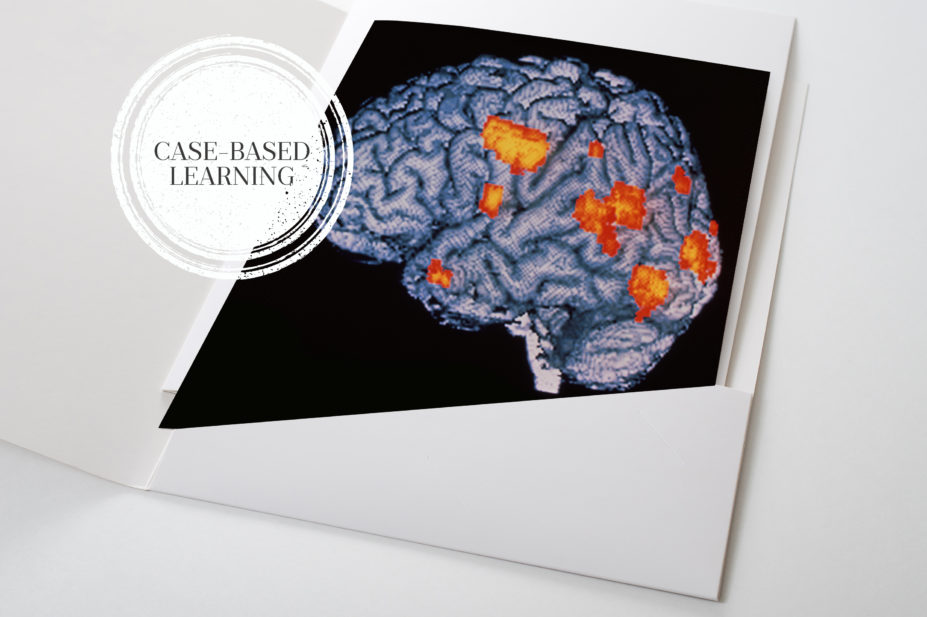
WELLCOME CENTRE HUMAN NEUROIMAGING/SCIENCE PHOTO LIBRARY
Learning objectives
After reading this article, individuals should be able to:
- Describe the management of schizophrenia;
- Understand pharmaceutical issues that occur during treatment with antipsychotics, especially clozapine;
- Explain how the Mental Health Act 1983 impacts on care;
- Understand the importance of multidisciplinary and patient-centred care in managing psychosis.
Background
Around 0.5–0.7% of the UK population is living with schizophrenia. Of these individuals, up to one-third are classified as treatment-resistant. This is defined as schizophrenia that has not responded to two different antipsychotics[1,2].
Clozapine is the most effective treatment for such patients[3]. It is recommended by the National Institute for Health and Care Excellence (NICE)[4], and is the only licensed medicine for this patient group[4,5]. For treatment-responsive patients, there should be a collaborative approach when choosing a treatment[4]. More information on the recognition and management of schizophrenia can be found in a previous article here, and in accompanying case studies here.
This case study aims to explore a patient’s journey in mental health services during a relapse of schizophrenia. It also aims to highlight good practice for communicating with patients with severe mental illness in all settings, and in explaining the role of clozapine.
Case presentation
Mr AT is a male, aged 26 years, who has been diagnosed with paranoid schizophrenia. He moved to the UK with his family from overseas five years ago. He lives with his parents in a small flat in London. His mother calls the police after he goes missing, finding his past two months’ medication untouched.
He is found at an airport, attempting to go through security without a ticket. He is confused and paranoid about the police asking him to come with them.
He is taken to A&E and is medically cleared (see Box 1)[6].
Box 1: Common differentials for psychotic symptoms
Medical conditions can present as psychosis. These include:
- Intoxication/effects of drugs (cannabis, stimulants, opioids, corticosteroids);
- Sepsis;
- Cerebrovascular disease;
- Temporal lobe epilepsy.
Mr AT’s history is taken by a psychiatrist, and his crisis plan sought (as per NICE recommendations) but he does not have one[7].
He has been under the care of mental health services for two years and disputes his diagnosis of paranoid schizophrenia. He was admitted to a psychiatric hospital 18 months ago where he was prescribed the antipsychotic amisulpride at 600mg daily.

He is teetotal, smokes ten cigarettes a day and smokes cannabis every day. His BMI is 26 and he has hypercholesterolaemia (total cholesterol = 6.1mmol/L, reference range <5mmol/L) but all other tests are normal.
He has no allergies. His only medication is amisulpride 600mg each morning, which he does not take.
Medicines reconciliation
Mr AT is transferred to a psychiatric ward and placed under Section 2 of the Mental Health Act, allowing detention for up to 28 days for assessment and treatment (see Box 2).
Box 2: The Mental Health Act 1983
This legislation allows for the detention and treatment of patients with serious mental illness, where urgent care is required. This is often referred to as “sectioning”.
It includes regulations about treatment against a patient’s consent to safeguard patients’ liberty, which become more stringent with longer detentions.
Patients may only be given medication to treat their mental illness without their consent and may refuse physical health treatment.
He denies any mental illness and tells the team they are conspiring with MI6. He is visibly experiencing auditory hallucinations: seen by him talking to himself and looking to empty corners of the room. Amisulpride is re-prescribed at 300mg, which he declines to take.
A pharmacy technician completes a medicines reconciliation and contacts the care coordinator. The technician provides information about Mr AT’s treatment and feels he is still unwell as he has continued to express paranoid beliefs about his neighbours and MI6.
The ward pharmacist speaks to the patient. As per NICE guidance on medicines adherence, they adopt a non-judgemental attitude[8]. Mr AT is provided with information on the benefits and side effects of the medication and is asked open questions regarding his reluctance to take it. For more information on non-adherence to medicines and mental illness, see Box 3[9].
Box 3: Medicines adherence and mental health
Adherence to medication is similar for both physical and mental health medicines: only about 50% of patients are adherent.
Side effects and lack of involvement in decision making often lead to poor adherence.
In mental illness, other factors are:
- Denial of illness (poor ‘insight’);
- Lack of contact by services;
- Cultural factors, such as family, religious or personal beliefs around mental illness or medication.
Mr AT reports gynaecomastia and impotence, and says that he will not take any antipsychotics as they are “poison designed by MI6”, although is unable to concentrate on the discussion owing to hearing voices.
He is prescribed clonazepam 1mg twice daily owing to his distress, which is to be reduced as treatment controls his psychosis. He is offered nicotine replacement therapy but decides to use an e-cigarette on the ward.
He is unable to weigh up information to make decisions owing to his chaotic thinking and is felt to not have capacity to make decisions on his treatment. The team debates what treatment to offer.
Patient preference
Mr AT refuses all options presented to him. A decision is made to administer against his will and aripiprazole is chosen as it is less likely to cause hyperprolactinaemia and sexual dysfunction. He then agrees to take tablets “if it will get me out of hospital”.
![Table 1: Common side effects of antipsychotics[9]](https://pharmaceutical-journal.com/wp-content/uploads/2022/01/clozapine-schizophrenia-Table-1-Common-side-effects-WM.jpg)
After eight weeks of treatment with orodispersible aripiprazole 15mg, Mr AT is able have a more coherent conversation, but is hallucinating and distressed. He is clearly under treated. The pharmacist attempts to complete a side-effect rating scale (Glasgow Antipsychotic Side-effect Scale [GASS]) but he declines. He is pacing around the ward in circles: it is felt he may be experiencing akathisia (restlessness) — a common side effect of antipsychotics (see Table 1).
Treatment review
The team feels clozapine is the best option owing to the treatment failure of two antipsychotics.
The team suggests this to Mr AT. He refuses, stating the ward is experimenting on him with new medication and he refuses to take another antipsychotics.
The pharmacist meets the patient with an occupational therapist to discuss what his goals are. Mr AT states he wants to go to college to become a carpenter. They discuss routes to achieve this, which all involve the first step of leaving hospital and the conclusion that clozapine is the best way to achieve this. The pharmacist clarifies the patient’s aripiprazole will not continue once clozapine is established. They leave information about clozapine with the patient and offer to return to discuss it further.
Mr AT agrees to take clozapine a week later (see Box 4)[10–14]. Aripiprazole is tapered and stopped.
Box 4: Clozapine characteristics
Clozapine significantly prolongs life and improves quality of life[10]. Delaying clozapine is associated with poorer outcomes for patients[11].
Clozapine is under-prescribed owing to healthcare professionals’ anxiety and unfamiliarity around its use[12–14].
It causes neutropenia in up to 3% of patients so regular monitoring is required. Twice-weekly monitoring is needed if neutrophils are <2 x109/L. Most patients should stop clozapine if neutrophils are <1.5×109/L. These ranges can differ from some laboratory definitions of neutropenia.
Other side effects include sedation, hypersalivation and weight gain. See Table 2 for red flags for serious side effects.
Clozapine is titrated up slowly to avoid cardiovascular complications. A treatment break of >48 hours warrants specialist advice for a retitration plan.
The pharmacist meets with Mr AT to discuss clozapine. He is told that this is likely to be a long-term treatment. The pharmacist acknowledges that the patient disagrees with his diagnosis, but this treatment is likely to prevent him from returning to hospital.
He is started on clozapine at 12.5mg at night, which is slowly increased. Pre- and post-dose monitoring of his vital signs is completed.
On day nine of the titration, his pulse is 115bpm. He otherwise feels well and blood tests show no signs of myocarditis (see Table 2), so the titration is continued but slowed.
After 3 weeks he is taking 150mg twice daily of clozapine and his symptoms have significantly improved: he is regularly bathing, not visibly hallucinating and engaging with staff.
The pharmacy technician completes a GASS form. Mr AT reports constipation, hypersalivation and sedation.
A pharmacist meets the patient to reiterate important counselling points, and discuss questions he may have about his treatment and how to manage side effects. Medication changes are made with the patients’ input:
- His constipation is monitored with a stool chart and he is started on senna 15mg at night;
- He is started on hyoscine hydrobromide 300 micrograms at night for salivation;
- He is switched to clozapine 300mg once daily at night to simplify his regime and reduce daytime sedation. His clonazepam is reduced and stopped.
Smoking is discussed owing to tobacco’s role as an enzyme inducer (more information on tobacco smoking and its potential drug interactions can be found in a previous article here). Mr AT states he will continue to use an e-cigarette for now. He is informed that if he starts smoking again, his clozapine may become less effective and he should immediately inform his team.
He is discharged a few weeks later via a home treatment team and attends a clinic once weekly. On each attendance, he has a full blood count taken and analysed on site. He is assessed by a pharmacy technician and nurse for side effects and adherence to treatment, and his smoking status is clarified.
The technician asks what he thinks the clozapine has done for him. Mr AT states he is still unsure about having a mental illness, but recognises that clozapine has helped him out of hospital and intends to continue taking it.
![Table 2: Red flags with clozapine[9]](https://pharmaceutical-journal.com/wp-content/uploads/2022/01/clozapine-schizophrenia-Table-2-Red-flags-with-clozapine-WM.jpg)
These can be confirmed/ruled out rapidly, so withholding clozapine until investigations are completed is prudent. Clozapine can always be restarted within 48 hours if clinically indicated, to avoid the need for re-titration.
Good practice in the pharmaceutical care of psychosis involves:
- Active patient involvement in discussions on treatment decisions;
- Regular review of treatment: discussing efficacy, side effects and the patient’s view and understanding of treatment;
- Multidisciplinary approaches to helping patients choose treatment;
- For patients who dispute their diagnosis and the need for treatment, open dialogue is important. Such discussions should involve the patient’s goals, which are likely to be shared by the team (rapid discharge, preventing admissions, reducing distress);
- Information about treatment should be provided regularly in both written and verbal form;
- Where appropriate, involve carers/next of kin in decision making and information sharing.
Important points
- Schizophrenia affects 1 in 200 people, meaning such patients will present regularly in all settings;
- Patients with acute psychosis, who are in recovery, may be managed by specialist teams, who are the best source of information for a patient’s care;
- Collaborating with the patient on a viable long-term treatment plan improves adherence;
- Clozapine is recommended where two antipsychotics have failed;
- Clozapine is a high-risk medicine, but the risks are manageable;
- Hydrocarbons produced by smoking (but not nicotine replacement therapy, e-cigarettes or chewing tobacco) induce the enzyme CYP1A2, which reduces clozapine levels markedly (up to 20–60%). Starting or stopping smoking could precipitate relapse or induce toxicity, respectively.
- 1Conley RR, Kelly DL. Management of treatment resistance in schizophrenia. Biological Psychiatry. 2001;50:898–911. doi:10.1016/s0006-3223(01)01271-9
- 2Gillespie AL, Samanaite R, Mill J, et al. Is treatment-resistant schizophrenia categorically distinct from treatment-responsive schizophrenia? a systematic review. BMC Psychiatry. 2017;17. doi:10.1186/s12888-016-1177-y
- 3Taylor DM. Clozapine for Treatment-Resistant Schizophrenia: Still the Gold Standard? CNS Drugs. 2017;31:177–80. doi:10.1007/s40263-017-0411-6
- 4Psychosis and schizophrenia in adults: prevention and management. NICE. 2014.https://www.nice.org.uk/guidance/cg178/ (accessed Jan 2022).
- 5Clozaril 25 mg tablets. Electronic medicines compendium. 2020.https://www.medicines.org.uk/emc/product/4411/smpc (accessed Jan 2022).
- 6Psychosis and schizophrenia: what else might it be? NICE. 2020.https://cks.nice.org.uk/topics/psychosis-schizophrenia/diagnosis/differential-diagnosis/ (accessed Jan 2022).
- 7Service user experience in adult mental health: improving the experience of care for people using adult NHS mental health services. NICE. 2011.https://www.nice.org.uk/guidance/cg136/ (accessed Jan 2022).
- 8Medicines adherence: involving patients in decisions about prescribed medicines and supporting adherence . NICE. 2009.https://www.nice.org.uk/guidance/cg76/ (accessed Jan 2022).
- 9Taylor D, Barnes T, Young A. The Maudsley Prescribing Guidelines in Psychiatry. 13th ed. Hoboken, New Jersey: : Wiley 2018.
- 10Meltzer HY, Burnett S, Bastani B, et al. Effects of Six Months of Clozapine Treatment on the Quality of Life of Chronic Schizophrenic Patients. PS. 1990;41:892–7. doi:10.1176/ps.41.8.892
- 11Üçok A, Çikrikçili U, Karabulut S, et al. Delayed initiation of clozapine may be related to poor response in treatment-resistant schizophrenia. International Clinical Psychopharmacology. 2015;30:290–5. doi:10.1097/yic.0000000000000086
- 12Whiskey E, Barnard A, Oloyede E, et al. An Evaluation of the Variation and Underuse of Clozapine in the United Kingdom. SSRN Journal. 2020. doi:10.2139/ssrn.3716864
- 13Nielsen J, Dahm M, Lublin H, et al. Psychiatrists’ attitude towards and knowledge of clozapine treatment. J Psychopharmacol. 2009;24:965–71. doi:10.1177/0269881108100320
- 14Verdoux H, Quiles C, Bachmann CJ, et al. Prescriber and institutional barriers and facilitators of clozapine use: A systematic review. Schizophrenia Research. 2018;201:10–9. doi:10.1016/j.schres.2018.05.046
- This article was corrected on 31 January 2022 to clarify that tobacco is an enzyme inducer, not an enzyme inhibitor
5 comments
You must be logged in to post a comment.



Useful structured introduction to the subject for clinical purposes
Thank you Amrit for your feedback, we are pleased that you found this article useful.
Michael Dowdall, Executive Editor, Research & Learning
Please note that smoking causes enzyme INDUCTION not INHIBITION as stated. (Via aromatic polyhydrocarbons, not nicotine)
Hi James. Thank you for bringing this to our attention. This has now been corrected.
Hannah Krol, Deputy Chief Subeditor
Only with Herbal formula I was able to cure my schizophrenia Illness with the product I purchase from Dr Sims Gomez Herbs A Clinic in South Africa